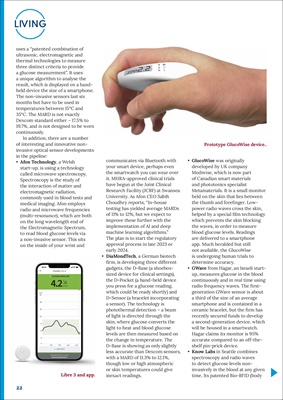
22
LIVING
Non-invasion of the body
scratchers
The Holy Grail of diabetes care is needle-free - or
non-invasive - glucose monitoring. Are we there yet?
By Susannah Hickling.
It's hardly any time at all since
anyone who needed to monitor
their glucose levels had to stab
themselves in the finger and
draw blood. Finger-prick testing
might be accurate but it's a painful,
relentless, primitive process that
can leave calluses over time. Small
wonder some people with diabetes
have been reluctant to finger-prick
and have seen poorer control as a
result. But all that is changing with
the advent of 'bloodless' glucose
monitoring - also called non-invasive
glucose monitoring.
What is non-invasive glucose
monitoring? It is a way - and there
are plenty - of measuring glucose
levels without piercing the skin to
sample blood. A review by diabetes
technology experts led by Professor
David Klonoff of the University of
California, San Francisco, of products
for monitoring glucose levels
published in June 2021 in the Journal
of Diabetes Science and Technology
identified three broad categories of
device - minimally invasive, noninvasive
optical and non-invasive
fluid sampling.
Almost everything that is
currently available slots into the
minimally invasive category. This
essentially covers continuous
glucose monitoring (CGM) and
flash technology, which have
brought comfort and convenience
for many. They can bring a better
understanding of your condition,
improved control and less waste,
since you use fewer, if any, disposable
test strips or lancets. But, as the
'minimally invasive' label suggests,
these monitors cannot be said to
be totally non-invasive, though of
course they're a far cry from the
relative brutality of finger-stick
testing. They rely on the need
to puncture the skin in order to
implant a thin sensing filament into
subcutaneous tissue to a depth of
around 4-5mm. The sensor has to be
periodically replaced, usually every 7
or 14 days.
Non-invasive optical glucose
monitoring involves passing a type
of radiation into a vascular area of
the body to extract information on
glucose levels without any need for
needles. Meanwhile, non-invasive
fluid sampling monitoring analyses a
fluid sample - typically tears, sweat,
Afon traditiona l watch with app.
saliva or urine - without piercing
the skin.
For these two types of needle-free
device, perfecting the technology
and replicating the accuracy of
finger-prick testing remain a
major challenge. This has been the
downfall of a number of non-invasive
monitors over the years. This
includes the Google contact lens,
which measured blood sugar in tears
- but, unfortunately, not consistently
enough - and the Gluco Watch,
which used an electrical charge to
bring glucose to the skin surface.
This was discontinued after wearers
reported accuracy issues and skin
irritation.
The sceptics of non-invasive
testing are many, with some believing